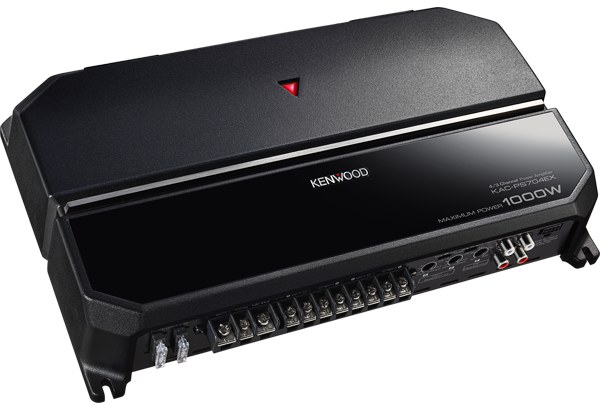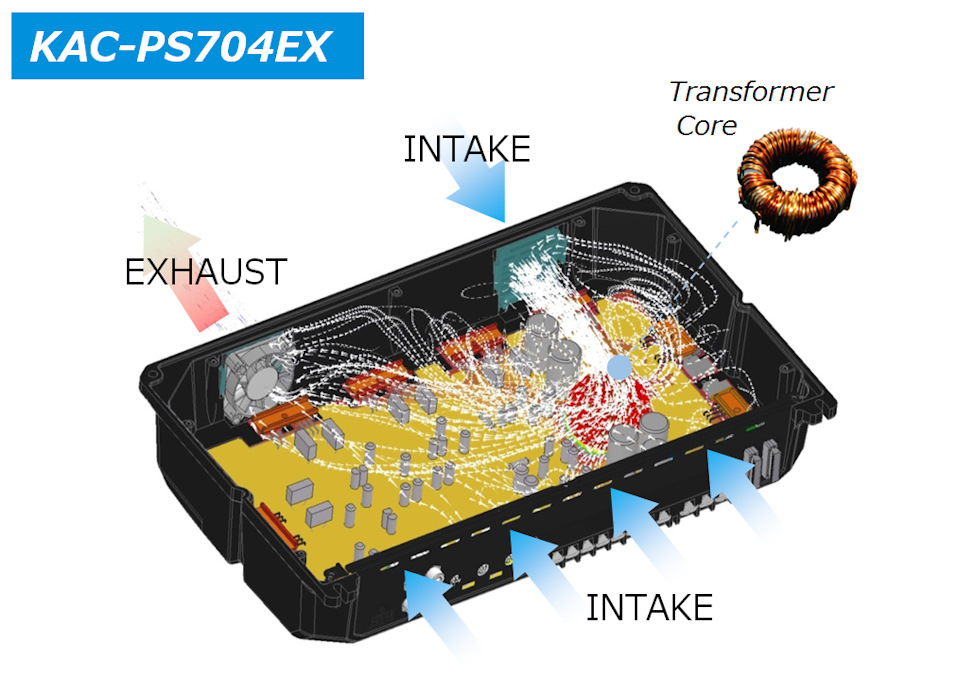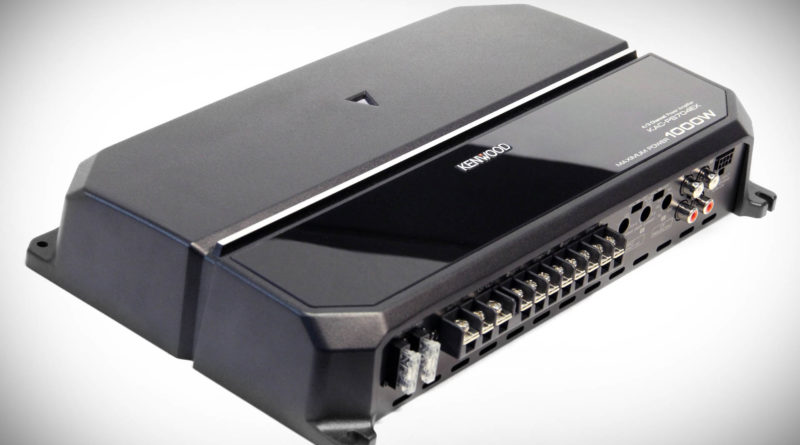Kenwood KAC-PS704EX Four Channel Amplifier
Product Details
Manufacturer: Kenwood
Website: link
Typical Selling price: £199.99 (Seen on line at £149.99)
WHAT IT IS
A four channel car audio amplifier with separate high pass and low pass crossovers, cast aluminium chassis, RCA or speaker level input, signal sensing power-on and high quality electronics to provide a 100dB signal to noise ratio. The KAC-PS704EX features dual push-pull cooling fans and separate signal/power geometries inside, for better fidelity. The RMS output at 4 Ohms and 2 Ohms power ratings are what is termed ‘CEA Compliant’, meaning the TRUE POWER RMS rating parameters, set by the Consumer Electronics Association of America, back in 2006, after some amp makers made stupid claims on their heatsinks. As it is, the two-and-a-half-plus-a-wee-bit method to describe the peak outputs of each of the four channels in here, to be 250W and thus print ‘1000W’ on the front, is a little enthusiastic but necessary to sell ’em and always has been. I was that ‘OW MANY WATTS MATE?’ customer
Kenwood KAC-PS704EX In A Nutshell
In A Nutshell
A superb amplifier for the money. A real good looker, with astonishing sound quality and tremendous amounts of power for most all applications. It sounds high end and has an effortless quality to the output I would advise running the amplifier full range, without using the crossovers, into high quality speakers. The best you can afford, as you WILL be able to hear the reason you bought them, with the Kenwood KAC-PS704EX. Happily recommended.
The SCORES
Overall 9.0
Sound Quality 9
Power Output 8
Features 9
Build Quality 9
Value For Money 10
Recommended by Talk Audio
Editor Review : Kenwood KAC-PS704EX Four Channel Amplifier
The price of ‘˜things’ has come down more than we could ever have imagined in our lifetime, due to the Chinese manufacturing boom. However the costs of stuff to us has always had to allow for the people selling said stuff to make a living. We Brits hate it, the P-word PROFIT. And in the past, years back, when I was a sales rep, I recall all the car radio dealers making a fuss about how there was no money in the game. This was lies and piffle, as after all, who would admit to being in a business where they were creaming it? You don’t want to encourage others to crowd your world. But I do clearly remember that at least ten of them in my area of the South East had bought brand spanking new Ford Escort RS Cosworth Turbos. The ones with the ridiculous ‘˜whale tail’ spoilers on their boot lids. Remember them? These massive spoilers with their two layers and weight of GRP, meant that the hatch on what was still a hatchback car, needed to have the most hench gas struts ever fitted to a UK car! As a result, more swivel-up bass boxes with twin tens or twelves were supported by Cosworth hatchback whale tail support struts than any other trend before or since.
So, to the Kenwood KAC-PS704EX. The KAC is the ‘˜Kenwood, Amplifier, Car’ prefix used forever, but the PS bit means ‘˜Performance Series’. That was always saved for their finest and this product is new and described as their ‘˜entry level’ amplifier and is priced accordingly. This 4x70W RMS (CEA-2006 rated) amp is RRP’d at £199 yet sells for £150 or even less. It has a two channel 70W sibling and a 4x40W RMS little sister, too. So what is the big deal?
Well, a few years back, this level of product would have been £399, sold at £349. This is suggested at £199 and I saw it on sale at £149.99! The features are all High End. Cast chassisforced air dual-fan cooling.separate power and signal path topologysignal sensing auto-on.dual high and low pass crossovers with their own slopes and frequency settings a shiny piano black part and an aluminium brushed logo.
This is utterly bonkers for the money and looks to me as a serious tilt at knocking the teeth out of a slew of USA offerings. For apart from a manufacturing path that does not involve any time in the USA, (so much else we get comes from America, after being shipped clear past us on a boat from China) I am also pretty certain that this price-quality quantum leap is entirely deliberate as a ploy to price for way less profit for the makers, but drive some sales to the otherwise not-sure-about it.
So what’s it like? I wired it up using the provided Molex speaker loom thing and failed to use the blue switching wire, deliberately, as these are two of the selling points and would be obviated if I just did it as normal. These features are about NOT needing to access an RCA feed, or to get to the back of a well-installed (or worse, deeply-embedded factory unit) to fit a signal cable. You save cost-effort and parts.
Hilarious for the truth for me was that I had to make a tiny loom, to connect the headunit speaker outputs to the wires of the Molex speaker level input assembly. As each wire is two conductors, and each end needed to be stripped, twisted, connected to the next and then insulated, before doing the same on the other end for eight conductors, the numbers of ‘˜operations’ versus plugging in two RCAs was absurd! (over 128) However, I didn’t have to remove seats to lay an RCA and power switching wire. But you still need 12V proper mains running, and while I know that power and RCA need to be kept apart, by the time you have run a power cable, is it really a lot of work to run an RCA? But hey, a good RCA can be a huge cost and this is a cheap amp, if only because it is being sold offensively cheaply versus the quality of the innards.
I used the Sony deck with the SACD of Pink Floyd and the broken display. I don’t need audio settings, just play and the highest resolution ever to come from car-disc, as rare as a unicorn, was poured down the speaker wires.
And always bearing in mind that somewhere inside the deck, the signal is being fed into a tiny amplifier, with all the distortions and compression that can mean due to its own little limitations, the speaker level out can never be as clean as the ‘˜source’ signal inside. Yet despite the lack of use of the line level outputs that were designed to take that clearer signal and send it to an amplifier, the sound was superb.
Layered, rich and dynamic, the old hippy music swelled, rose and crescendoed all over my landing. It was awesome. I played the VIETA 6×9 three ways with the compression driven tweeter and I also played the Morel Virtus Nano speakers that despite being as flat as a fish, sound absolutely delicious. The bass was juicy and rich and the treble was fast and tinkly. The part in TIME, when all the clocks start ticking and chiming is for me, one of the best ever iconic hifi tests. I recall standing outside a bar in Spain, where an owner used a posh sound system as his attract-mode, with a pair of JBL studio monitors hanging in the area outside to the street. I just stood there transfixed in my swimming trunks, marvelling.
The crossovers are by nature limited to the simpler Japanese type by a switch-fixed frequency for one and an adjuster for frequency for the other, both with fixed slopes. Fancy Q controls and slope adjusters are not the thing you will find these days on amps, as most posh crossovers are digital these days. But that fan cooled cast chassis heatsink is a piece of proper posh. That cast thing used to be Rockford -Fosgate’s massive selling point.. and here it is at budget level.
A gorgeous looker, the sweet red LED on the top lights instantly the system is live, that sensing works a treat and no blue wire was used.
I stood before the rig and just bathed in the richness. It was so damn good, that I rapidly moved into the ‘now this system needs a really deep-reaching subwoofer underpinning the deep stuff..’ which means the main part was so good that I was off onto the next thought. I truly enjoyed it and yet still have problems grasping how the Performance Series can now be an entry level product.
A superb amplifier for the money. A real good looker, with astonishing sound quality and tremendous amounts of power for most all applications. It sounds high end and has an effortless quality to the output I would advise running the amplifier full range, without using the crossovers, into high quality speakers. The best you can afford, as you WILL be able to hear the reason you bought them, with the Kenwood KAC-704EX. Happily recommended.
The Intake and Exhaust fans and what they do in a KAC-PS704EX Full Features & Specifications
Full Features & Specifications
Load Capability 2Ω Stable
Maximum power output 1000W
Rated power output (4Ω) 70W x 4 (4Ω)
Rated power output 100W x 4 (4Ω)
Bridged power output (4Ω) 200W x 2
CEA-2006 Compliant Yes
Low-pass Filter Yes
High-pass Fliter Yes
Switched Mode Power supply Yes, MOS-FET
Cooling Fan Yes
Signal Sensing Turn-on Yes
Line in 4 RCA / Speaker level
Speaker level Input Yes
Single Side Terminals Yes
Die-Cast Aluminium Heat Sink Yes
Rated power output (4Ω, 14,4V) 70W x 4 (20Hz ~ 20000Hz, 1%THD)
Rated power output (2Ω, 14,4V) 100W x 4 (1000Hz, 1%THD)
Rated power output (CEA-2006) 70Watts RMS x 4 at 4Ω and 1% THD
Low-pass Filter 50 to 200Hz (24dB/oct)(B-Channel)
High-pass Filter 80Hz (-12dB/oct)A-channel only
RCA Input Sensitivity 0.2 to 5V
Speaker Level Input Sensitivity 4 to 12V
Input Impedance 10k„¦
Signal to Noise Ratio 100dB
Signal to noise ratio (CEA-2006) 80dBa (Reference: 1 Watt into 4 Ohms)
Frequency response (+0dB, -3dB) 20Hz to 50Hz
Operating voltage 14.4V (11V to 16V allowable)
Maximum current consumption 32A
Dimensions (WxHxD) 335 x 56 x 204(mm),
Weight 2.6kg


